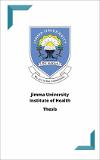IPHC-E Repository System
Predictors of intention to use maternity waiting home among pregnant women in Gomma woreda of Jimma zone, South West Ethiopia: Application of theory of planned behavior (TPB) model
- Home
- →
- Universities
- →
- Jimma University, Institute of Health
- →
- JU Theses and Dissertations
- →
- View Item
JavaScript is disabled for your browser. Some features of this site may not work without it.
| dc.contributor.author | Bayih, Getnet | |
| dc.date.accessioned | 2021-05-12T07:39:22Z | |
| dc.date.available | 2021-05-12T07:39:22Z | |
| dc.date.issued | 2016-06-30 | |
| dc.identifier.uri | http://repository.iifphc.org/handle/123456789/1296 | |
| dc.identifier.uri | https://repository.ju.edu.et/handle/123456789/718 | |
| dc.identifier.uri | ||
| dc.description.abstract | Introduction: Maternity waiting homes are temporary shelters for pregnant women located near to health institutions and it has been endorsed by WHO since 1996 as one component of a comprehensive package to reduce maternal morbidity and mortality. Maternal health is one of the major worldwide health challenges. In Ethiopia access to comprehensive emergency obstetric care is limited. Despite long years of existence of this maternity waiting home service in Ethiopia, the practice has not been adequately assessed so far. Objective: To assess predictors of intention to use maternity waiting home among pregnant women in Gomma woreda of Jimma Zone, South West Ethiopia March 2016. Method: Facility based cross sectional study design triangulated with qualitative study method was conducted from March 06-30/2016. Pregnant women attending ANC clinics were taken by using consecutive sampling technique. Single population proportion formula was used to calculate 387 pregnant women. Face to face exit interview was used to collect data by trained data collectors using structured and pretested questionnaire. Data was checked for completeness and entered in epi data 3.1 versions and exported to SPSS version20.0 for analysis. Descriptive statistics were calculated. Simple linear regression analysis was done to assess association b/n dependent and independent variables. Multiple linear regression analysis was done to identify predictors of intention at p-value less 0.05 with 95% confidence interval. In-depth interview was conducted for pregnant women and HEWs to collect the qualitative data. The qualitative data was transcribed manually and triangulated with quantitative data. Result: The mean age of respondents was 26.45± 4.762 SD years. One hundred forty eight (38.7%) respondents had past MWH experiences. Majority of the respondents 232(77.1%) gave their last child birth in health institution. Direct attitude, subjective norm and perceived behavioral control had mean score of 16.78 (SD=2.868), 15.61(SD=1.918) and 12.86 (SD=4.854) respectively. Intention has mean score of 14.52 (SD= 4.012). Attitude, subjective norm, perceived behavioral control, giving child birth in health institutions and past MWH experiences were associated with intention to use MWH. Conclusion & recommendation: Attitude, subjective norm, perceived behavioral control, giving child birth in health institutions & having past experience on MWH were predictors of Intention. Intervention programs targeted to increase perceived control belief on shortage of food and caring of pregnant women family should be designed & implemented. | |
| dc.language.iso | English | |
| dc.publisher | Jimma University | |
| dc.subject | Maternal health | |
| dc.title | Predictors of intention to use maternity waiting home among pregnant women in Gomma woreda of Jimma zone, South West Ethiopia: Application of theory of planned behavior (TPB) model | |
| dc.type | Thesis |
